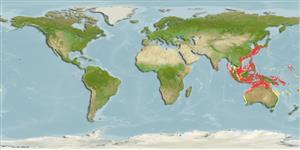Common names from other countries
Environment: milieu / climate zone / depth range / distribution range
Ecologia
marinhas associadas(os) a recifes. Subtropical
Western Pacific: Japan to Celebes, Indonesia.
Tamanho / Peso / Idade
Maturity: Lm ? range ? - ? cm
Max length : 16.0 cm SL macho/indeterminado; (Ref. 41299)
Espinhos dorsais (total) : 10; Raios dorsais (total) : 13 - 14; Espinhos anais: 3; Raios anais : 7.
Inhabits deeper rocky reefs (Ref. 41299).
Ciclo de vida ou comportamento de acasalamento
Maturities | Reprodução | Spawnings | Egg(s) | Fecundities | Larvas
Heemstra, P.C. and J.E. Randall, 1999. Serranidae. p. 2442-2547. In K.E. Carpenter and V.H. Niem (eds.) FAO species identification guide for fishery purposes. The living marine resources of the Western Central Pacific. Vol. 4. Bony fishes part 2 (Mugilidae to Carangidae). Rome, FAO. 2069-2790 p. (Ref. 39231)
Status na Lista Vermelha da UICN (Ref. 130435)
CITES (Ref. 128078)
Not Evaluated
Ameaça para os humanos
Harmless
Uso pelos humanos
Ferramentas
Relatórios especiais
Baixar XML
Fontes da internet
Estimates based on models
Preferred temperature (Ref.
115969): 15.6 - 27.6, mean 23.9 (based on 400 cells).
Índice de diversidade filogenética (Ref.
82804): PD
50 = 0.5000 [Uniqueness, from 0.5 = low to 2.0 = high].
Nível Trófico (Ref.
69278): 3.4 ±0.4 se; based on size and trophs of closest relatives
Resiliência (Ref.
120179): Elevada, tempo mínimo de duplicação da população menor que 15 meses (Preliminary K or Fecundity.).
Fishing Vulnerability (Ref.
59153): Low vulnerability (10 of 100).
